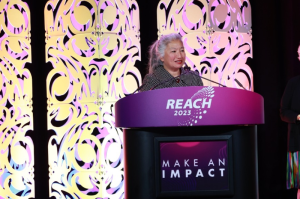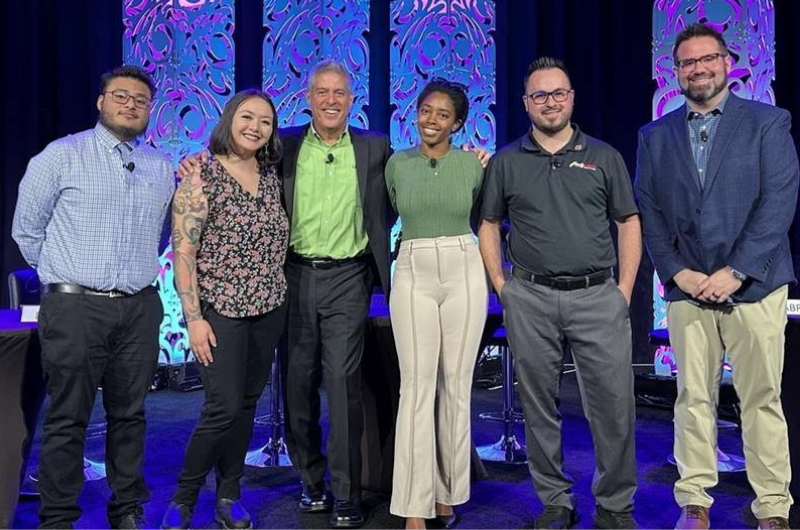


On Wednesday morning, Neil Goldman — president of Goldman Consulting & Strategy Inc. — gave attendees of the California and Nevada Credit Union Leagues’ REACH 2023 conference an inside look at what younger Millennials and Generation Z consumers are thinking, and how they view credit unions versus digital banks, big banks, and regional/community banks.
(View and download event photos from the REACH 2023 Photo Galleries)
In “Is Perception Reality? The Inside View of the California and Nevada Consumer,” Goldman brought five local Las Vegas-area Millennial and Generation Z consumers from all walks of life on stage to hold a “live” focus group session when it came to their perceptions about banking conveniences, accessibility, rewards, financial service providers, products and services, technology, safety and security, ease of use, and financial advice.
He also revealed the results of a California-Nevada consumer banking research project, using net promoter score (NPS) “detractors,” “promoters,” and “passives.” When respondents were asked how likely they would be to recommend the following four financial service providers (in general), they responded with the following NPS scores:
“They’re all seen as negative,” Goldman noted. The survey then asked respondents to rate their own primary financial service provider, and consumers responded with the following NPS scores:
“Credit unions win here and we’re doing well, comparatively speaking,” Goldman said. The survey then asked respondents how they would rate their financial institution “by name,” and consumers responded with the following NPS scores:
“You can see that banks are still at the cold end of the spectrum — some are even freezing,” Goldman said. “And credit unions hold the highest. Again — good news.”
Nonetheless, he discussed how credit unions cannot rest on their laurels when it comes to these results. “Do credit unions still own trust and service? Yes,” Goldman said. “But we don’t win on safety, security and fraud protection, or products and services, or online and mobile banking, or even access and convenience.”
He used Chime as an example. The digital fintech player has specifically targeted low-income Millennial and Gen Z consumers.
“Who are credit unions trying to serve? And what does that group need?,” Goldman asked. “Young people say they want safety, security and fraud protection first — and they rate trustworthiness second, access and convenience third, financial stability fourth, and customer service fifth. Today, in general, credit unions have a different type of consumer who you are attracting and serving.”
He talked about a recent Filene Research Institute report and survey results that focused on consumer personalities regarding where they fit into the following categories: learning and growth, security, wanting a challenge, control-seekers, okay with the status quo, demanding and complex, and status-seekers. In the NPS scoring world, credit unions win in all categories.
“But where do we win most?,” Goldman asked. “Learning and growing, security, and wanting a challenge.” He also noted where Californians and Nevadans are doing their banking according to the Filene report: 70.4 percent at large multi-state banks; 13.8 percent at credit unions; 12.7 percent at digital banks; and 3 percent at regional/community banks. Also, large multi-state bank usage increases with increasing income (whereas digital bank usage decreases with increasing income).
Overall, regarding the likelihood of choosing a credit union versus another financial service provider in California and Nevada: 46.2 percent are “very likely” to choose a large bank; 42.4 percent are “very likely” to choose a digital bank; and 37.7 percent are “very likely” to choose a credit union (there were no results for community/regional banks).
Consumers who are more likely to choose a credit union “more than average” are those already using a credit union currently as their primary financial service provider, as well as those who are current members (in general), black/African-Americans, white/Caucasians, and Millennials. However, those less likely to choose a credit union are digital bank users, Asians, Hispanic/Latinos, Gen Z, large multi-state bank users, past credit union members, and those who have never used a credit union.
“The only place we win the most is with ‘current credit union members’,” Goldman said. “The perception from the other crowd is that they cannot understand the value and contributions that members and their credit unions have together.”
Goldman said demographic targeting means focusing, but it does not mean exclusion. That was his challenge for attendees so they can compete against the competition in financial services — to know “who” exactly they are targeting, aligning their focus with the groups they are truly trying to serve.
“Consumers buy on perceived value, but what is value?,” Goldman asked. “Your credit unions need to make contributions to your members so they add value back to each other and your credit union. Mission, vision, and values are essential in creating a strategic foundation, but there’s something missing, and that’s your target — your niche. You need to inform yourself about who you are serving so you can be a beacon of light and attract the right target audience through contributions and the value you create.”
Stay Engaged During REACH
Attendees and League staff will be sharing photos, comments, and memories through X (@CANVleagues) and LinkedIn (#CUatREACH).
REACH is one of the credit union industry’s premier annual events, attracting leaders and system partners from across California, Nevada and the United States. This year it’s held from October 22 – 26 at the Cosmopolitan of Las Vegas in Las Vegas, NV!
2855 East Guasti Rd., Suite 202
Ontario, CA 91761
909.212.6000
1201 K. St., Suite 1050
Sacramento, CA 95814-3992
916.325.1360
c/o Great Basin FCU
9770 South Virginia Street
Reno, NV 89511-5941
202.638.5777 www.cuna.org
www.dfpi.ca.gov
Clothilde “Cloey” V. Hewlett — 415.263.8500
fid.state.nv.us
702.486.4120 (Las Vegas)
775.684.2970 (Carson City)